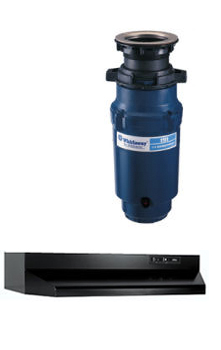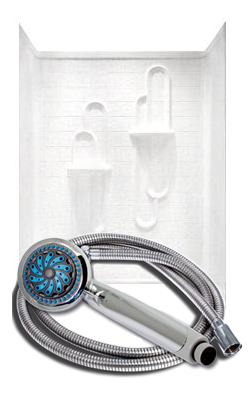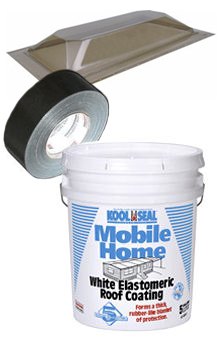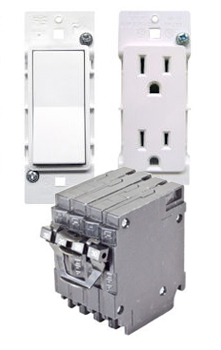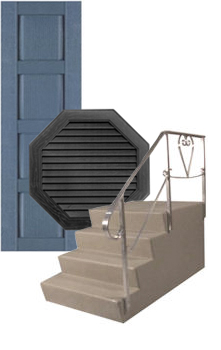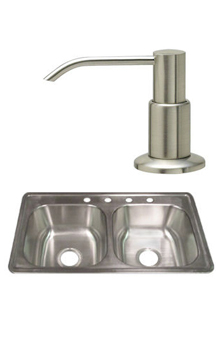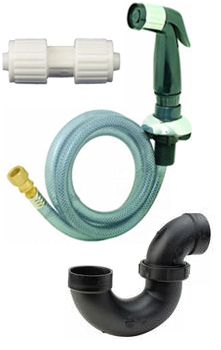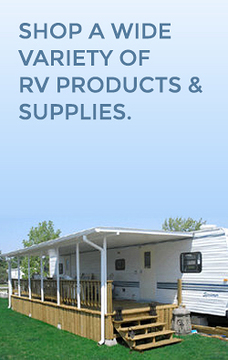
Are you dealing with slow water flow, bad smells, strange gurgling noises, or other weird signs in your mobile home’s plumbing? Well, the culprit might be your mobile home’s ventilation system.
People often confuse venting issues with drainage problems in mobile homes. Still, the real trouble often stems from poor or uneven venting design. The good news is that some of these venting and drainage problems can be figured out and solved with some simple DIY.
In this article, we’ll guide you in recognizing and tackling these issues and, hopefully, help you fix them.
Parts of Your Mobile Home Plumbing System
Every mobile home plumbing system is made up of 3 systems: the Water Supply System, Drain or Waste System, and Ventilation System. All three of these systems work in tandem to ensure that your plumbing runs smoothly.
Water Supply System
The water system in your mobile home is like the body’s circulation system. The supply line is usually a 3/8″ to 1″ copper or Pex line that brings water in from the mainline. The water will then branch at your water heater to allow some water to be heated for hot. At the same time, the remaining cold water runs parallel to the shower, sinks, and toilets.
These pipes must be strong with tight connections called fitting to handle high-pressure water. For example, the pressure forces the water out when you turn the handle on a sink. The more you open the faucet, the more water comes out. But when you want hot water, it has to pass through the water heater first.
Drain or Waste System
The drain or waste system is designed to remove used water and waste from your home. This system consists of pipes, drains, and sewer lines that carry the wastewater to your septic tank or the city sewer system.
Drain-waste lines rely on gravity, traps, and vent lines to keep everything working smoothly. These elements help maintain the right pressure inside the pipes and push any unpleasant sewer odors up and away from your house. Think of this system as completely closed off with a positive and negative vacuum or pressure. If there’s not enough pressure inside the pipes, waste won’t flow into the sewer, and it might back-flow instead.
You can usually spot the big white drain pipes under your mobile home. They connect your water fixtures to the sewer or septic system. They’re sloped so that gravity can help move the waste along.
Ventilation System
Ventilation lines work alongside your drain-waste pipes but are considered a separate system. The ventilation line has two jobs:
- Maintains the pressure in the drain lines to help wastewater drain smoothly
- Act as a route for sewer odor to follow, preventing them from entering your home
The ventilation system allows air to enter your drain lines so it can maintain the right atmospheric pressure in the pipe. Without this, draining water would create a vacuum, pulling all the water out of the P-traps.
If something goes wrong with the ventilation system, it can lead to various problems. We’ll go into these issues in more detail below.
Elements of a Mobile Home Ventilation System
The ventilation system plays a crucial role in maintaining your plumbing system’s proper flow and balance. It consists of various components that prevent problems such as airlock, slow drainage, and sewer gas buildup. Let’s take a closer look at the elements of a mobile home ventilation system:
Direct Vents or Vent Stack
The most common vent is called a direct vent, sometimes called a vent stack, soil stack, or VTR (which stands for ‘vent through the roof’). You’ll often spot these vents on the roof or along the side of a house where the drain pipe connects to the sewer line. They help sewer gasses to escape into the atmosphere, preventing them from entering your home.
Sometimes, these direct vents can get clogged with leaves or any other debris that can get stuck in your roof’s pipe.
Wet Vent
A wet vent is a pipe that serves as both a drain and a vent. They drain water from one fixture and vent another. In contrast, a dry vent only circulates air in one fixture and does not carry water. Wet vents are commonly used for fixtures like sinks and toilets.
Many folks like using wet vent plumbing because it’s a money and time-saver. For example, when you’re adding a new bathroom to your mobile home, it can be tricky to make a new pipe for draining water– a wet vent is a lot easier. But here’s the catch: these wet vents have rules and limits and can change depending on where you live. So, while they’re great, you need to check with your local regulations.
Auto Vents or Air Admittance Valves
An Air Admittance Valve, or AAV, is a small one-way valve that allows air to enter the drainage system when negative pressure exists. That negative pressure then pushes the valve open, allowing air to enter the pipe. Once the pressure returns to normal, the AAV closes by gravity and seals off the vent. They are typically used when a drain pipe and direct vent are difficult or impossible to connect.
Many plumbers will use auto vents instead of running a wet or direct vent in new home construction and remodeling. The best thing about using auto vents is that they are cheaper and quicker to install because they use less pipe, and you only have to screw an auto vent.
P-Traps
P-traps, known for their U-shaped design, have a unique bend that filters wastewater as it enters a plumbing system. Inside this bend, there’s a part shaped like a J that holds some water, making a seal of 1-½ to 2 inches of water at the top. This seal stops sewer gasses and odor from coming into your house.
The top of the U-shaped bend in the p-trap is called the weir. If there’s too much water, it will start to flow into the wall pipe. Every time you use a sink or other fixture, new dirty water goes through the p-trap, and the old water in the bend gets replaced with fresh water.
5 Signs of a Ventilation Issue in Your Mobile Home
Identifying vent issues early is key to preventing more extensive plumbing problems. Here are six common signs that you may have ventilation issues in your mobile home:
Sewer Odors
If you notice foul smells coming from your drains or fixtures, it’s a clear sign something is wrong. The unpleasant odors are usually due to sewer gasses escaping into your home. If you do, it might be because of problems with your P-trap.
Toilet and sink drains have a P-trap holding small amounts of water after draining the toilet or sink. The water creates a barrier to stop odors from leaving the drain system and creating unpleasant smells in your home. But when the air pressure from the vent is insufficient, the water can drain. When this happens, sewer odors won’t have anything blocking them from escaping into your home.
Water Heater Odors
Not all foul odors are caused by venting problems. A bad water odor could be coming from your water heater.
Slow Drainage
When water in your sink or bathtub drains slowly, it’s a sign that something might be wrong with the plumbing. It could be due to a poorly set up wet vent, or something might be blocking the pipe. So, before you start looking into the wet vent, it’s a good idea to check for a blockage.
You can do this by using a plumbing snake or an auger to try and clear the clog. If you have an auto vent and the water drains slowly, you can try removing it and see if it flows properly. If it does, you might need to replace the auto vent.
But if these DIY methods don’t work, it’s time to contact a professional plumber. They have powerful tools, like industrial-strength snakes, that can unclog almost any pipe. They’ll be able to get your plumbing back in working order.
Gurgling
Typically, you shouldn’t hear gurgling sounds when water goes down the drain. If you hear strange sounds, especially from your toilet or bathroom sink, it might mean there’s an issue with how air moves through the pipes. But don’t mix up these sounds with the regular water flow noises – they’re not the same.
A gurgling noise happens when pipe airflow is restricted, making it difficult for wastewater to move within the drain pipes.
Missing Water in Your Toilet
If your toilet bowl is empty, it’s likely not because of your dog.
When your toilet doesn’t fill up with water after you flush, or if the water level in the bowl goes up or down unexpectedly, it might be a sign of a leak in the pipes or a problem with the ventilation. When there isn’t enough pressure in the pipes, water from the tank or the toilet bowl can escape, leading to uneven water levels.
Air Bubbles in Your Toilet Water
When you flush your toilet, air bubbles in the water are a sign that your plumbing system isn’t venting correctly. The bubbles usually form as the pipes try to obtain sufficient air to balance internal pressure.
Wrapping Up
Your mobile home’s plumbing system is a complex network of water supply, drainage, and ventilation systems that work together to keep things running smoothly. When it comes to common issues like slow drainage, strange noises, or unpleasant odors, the often-overlooked culprit might be your ventilation system.
By understanding the key components of your mobile home’s ventilation system, like direct vents, wet vents, auto vents, and P-traps, you can start to identify and address problems early on. With a little DIY know-how and, if needed, the assistance of a professional plumber, you can tackle these ventilation issues head-on and ensure your mobile home’s plumbing functions as it should.
As always, the Mobile Home Parts Store team is here to help you with all the mobile home parts and supplies you need to complete your plumbing project! Check out our wide selection of plumbing supplies, Flair-It Fittings, and Sea Tech Quick Connect Fittings.
Tags: mobile home, Mobile Home Parts Store, mobile home plumbing, mobile home repair, plumbing


